
Mongolian beef might be one of the most popular Chinese takeout dishes of all time. Along with Black Pepper Steak, Sesame Chicken, Sweet and Sour Chicken, and Beef Chow Fun, it’s one of the most requested dishes among readers of this blog.
It might seem daunting to make your favorite takeout dish at home, but you’d be surprised how easy it is once you understand the workflow. Let’s dive in and learn how to make this dish work!
Mongolian beef ingredients and prep
Even though Mongolian beef is not a traditional Chinese dish, I made my own interpretation of it by adding extra aromatics and Shaoxing wine, while reducing the salt and sugar. It results in a well balanced dish with tender beef in a rich brown sauce that is not too sweet yet super fragrant.
1. Choose the right cut of beef
My favorite cuts for stir fry are flank steak and plate steak. These cuts are cheaper than sirloin and ribeye, yet they yield very tender results.
If you have to use a cheaper cut, such as round roast or brisket, there is a quick method to tenderize the beef. Sprinkle 1/4 teaspoon of baking soda onto the beef along with the other marinade ingredients, then mix very thoroughly to coat the beef. Chinese restaurants commonly use this method so they can use cheaper cuts of beef. I’ve documented the method in this Orange Beef recipe.
Also, make sure you always slice the beef perpendicular to the grain, which is another key to creating a melt-in-your-mouth texture.
2. Use plenty of fresh aromatics
This might be the most important component of a fragrant stir fry. Make sure you add plenty of fresh garlic, ginger, and green onion. They will give the sauce a depth of flavor and fresh taste, just like you’d get in a Chinese restaurant.
3. Marinate the meat
This key step takes an extra 3 minutes but it will make such a difference to your dish. Using Shaoxing wine and salt makes the beef so much more flavorful and so much richer. Once you’re done with the marinade, coat the meat with some cornstarch. Not only does it yield a crispy surface, but it also protects the beef from the hot pan so it won’t be overcooked.
4. Mise en place
When you’re ready to cook, your table should have:
- Sauce
- Marinated beef coated with cornstarch
- Green onion
- Ginger and garlic (can be combined in one bowl)

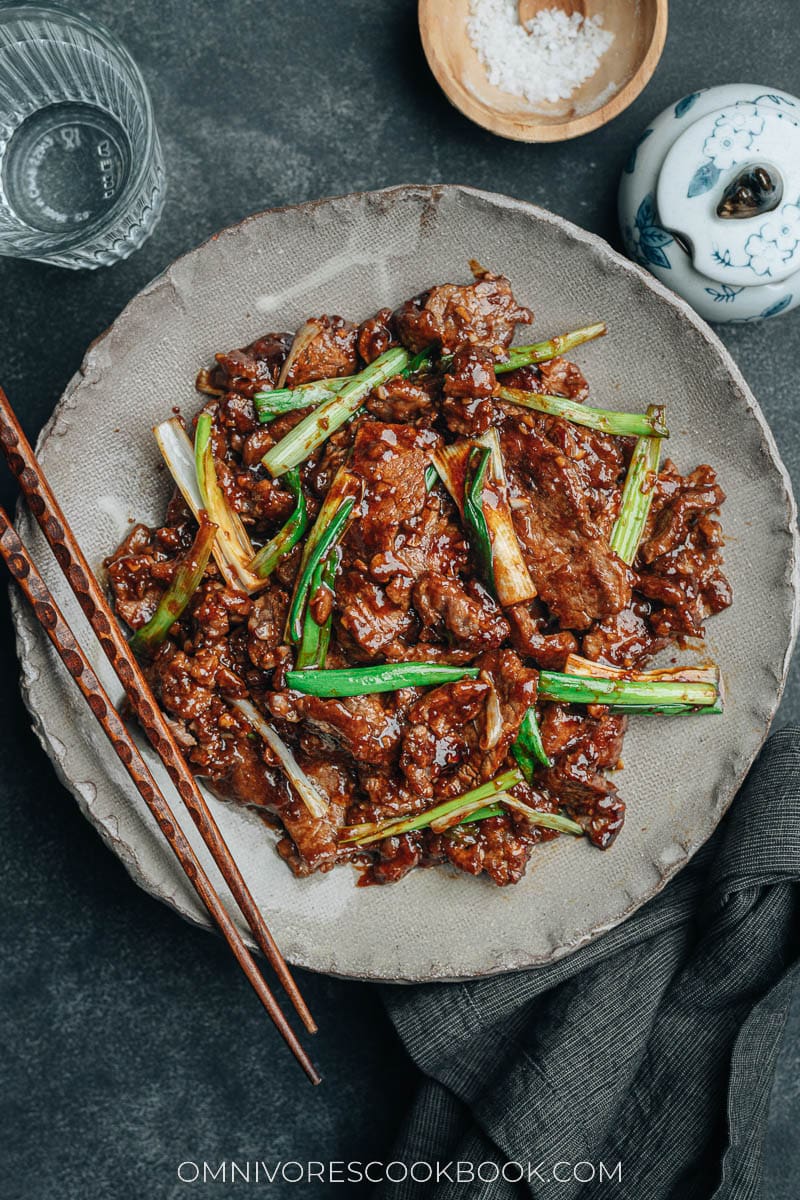
How to cook Mongolian Beef
1. How to cook beef properly without a wok
The first thing to remember is that you should let the beef sear in the hot pan without moving it too much. I know, it sounds like this is contradictory to the word “stir-fry”! Just like when browning your meat before making a stew, leaving the beef in the pan without moving it at the start of a stir fry will brown the bottom while maintaining a hot temperature in the pan.
Once you heat up the pan, spread the beef into a single layer with the help of a pair of tongs (or chopsticks). Then grill the meat, without touching, for at least 1 minute. Then use a spatula to flip to cook the other side. In the end, you will get perfectly seared beef that is medium rare inside. The beef will be cooked perfectly after you add the sauce, and it will also remain juicy and tender.
2. Stir fry workflow
Different from a lot of Western-style cooking, Chinese stir fry happens very quickly. Once you have everything prepared, the stir fry process is usually finished in less than 5 minutes. This means that you should have done all the prep and have all the ingredients ready and near your stove. Make sure to go through all the recipe directions so you have an idea of what to do next.
- Spread the beef with minimal overlapping and sear the bottom side
- Flip to cook the other side, then immediately transfer to a plate
- Saute the aromatics
- Add the sauce and stir to thicken it
- Add back the beef and the green onion
- Quickly mix everything together
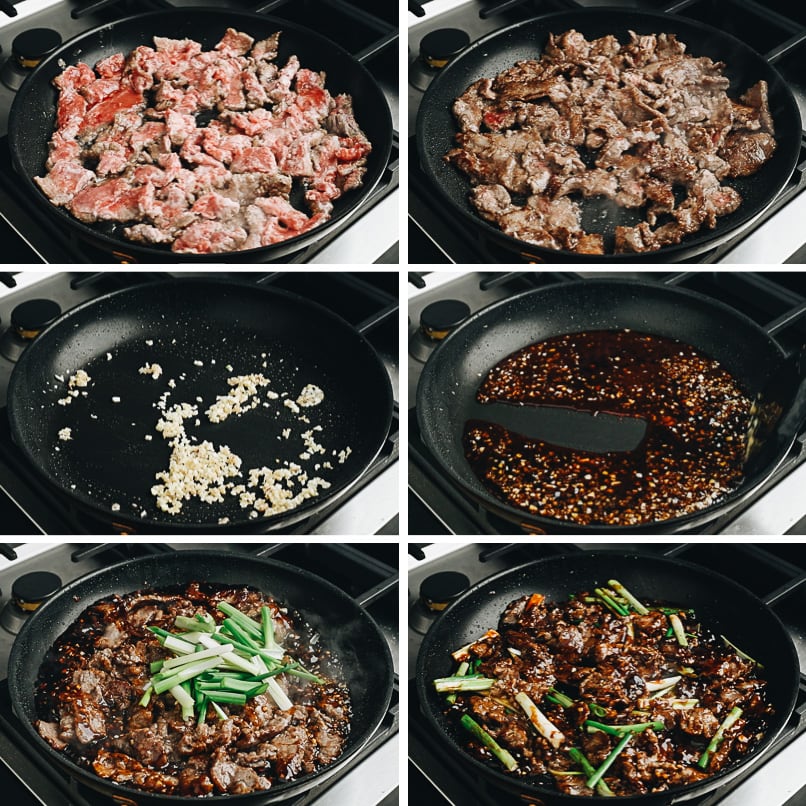
That’s it! You’ll find the dish so easy to make once you try it out!
Serve the sticky, tender beef on top of some steamed rice, and you’ll have dinner ready!
Happy cooking and I hope you enjoy this dish as much as I do!
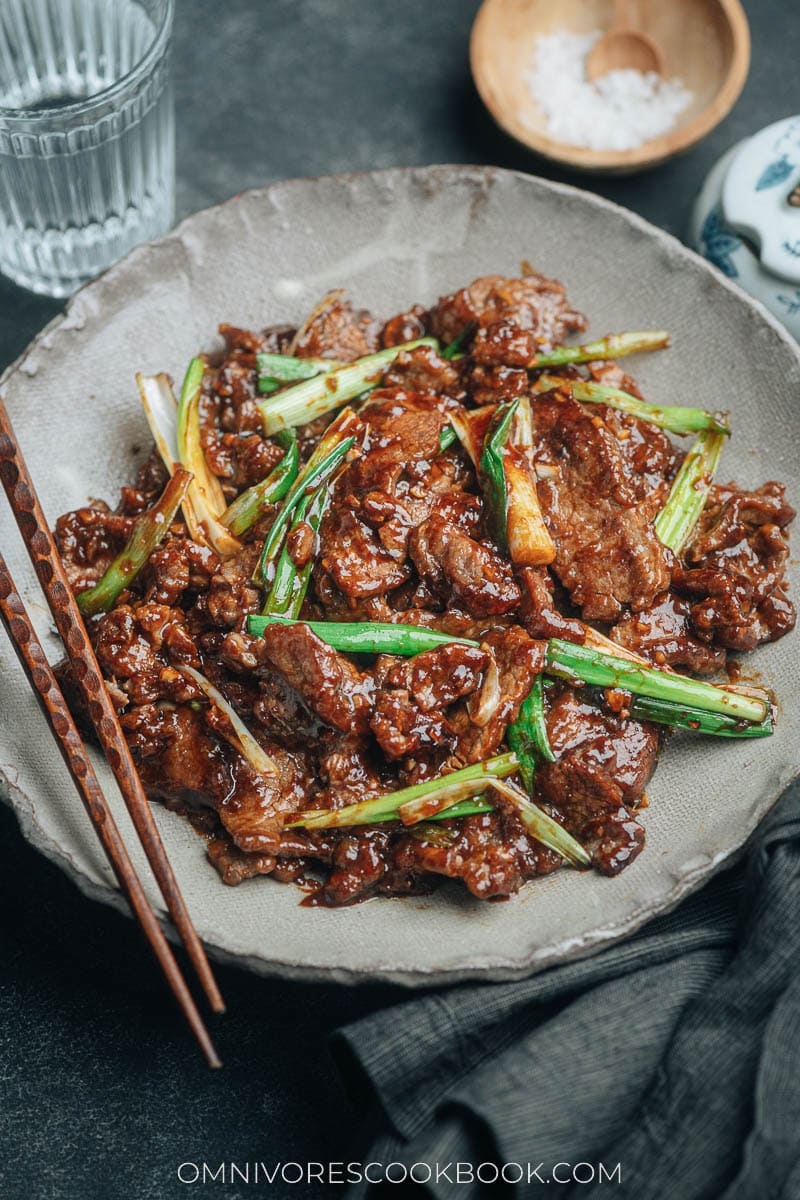
More Asian takeout recipes
Chinese Cooking Made Easy
Are you new to this website? This free email series is a great place to start. I’ll walk you through a few of my most popular recipes and show you how and why they work. You’ll quickly start to cook better Chinese food in your own kitchen.
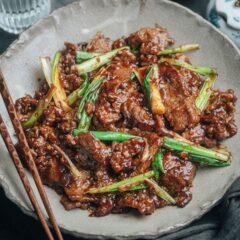
Mongolian Beef (Without Using a Wok)
Ingredients
Marinade
- 1 lbs (450 g) flank steak , sliced against the grain into 1/4” (1/2 cm) thick pieces (*Footnote 1)
- 2 tablespoons Shaoxing wine (or dry sherry)
- 1 teaspoon ginger , grated
- 1/2 teaspoon salt
Sauce
- 1/4 cup chicken stock (or water)
- 2 tablespoons light soy sauce (or soy sauce)
- 2 teaspoons dark soy sauce (or soy sauce)
- 2 tablespoons sugar
- 2 teaspoons cornstarch
Stir fry
- 1/4 cup cornstarch
- 3 tablespoons peanut oil (or vegetable oil)
- 2 teaspoons ginger , minced
- 3 cloves garlic , minced
- 4 green onions , cut into 2” (5 cm) pieces, then halved lengthwise
Instructions
- Combine flank steak, Shaoxing wine, ginger, and salt in a large bowl. Gently mix well with your hand. Let marinate at room temperature for 15 minutes.
- Mix all the sauce ingredients in a medium-sized bowl.
- When you’re ready to cook, add the cornstarch to the marinated beef. Mix to coat all the beef pieces with cornstarch.
- Heat peanut oil in a large nonstick skillet until hot. Spread the steak with minimal overlapping (*Footnote 2). Use a pair of tongs to rearrange the beef, if necessary. Let cook for 1 minute without moving, or until the bottom turns golden brown. Flip and cook the other side, 40 seconds or so, until golden but the inside is still a bit pink. Transfer the steak to a big plate.
- If there is a lot of oil left in the pan, use a couple layers of kitchen paper towel held in a pair of tongs to remove any extra oil, leaving 1 tablespoon of oil in the pan.
- Add the ginger, garlic, and the white part of the green onion into the skillet. Cook and stir for 30 seconds to release the fragrance.
- Stir the sauce again until the cornstarch is fully dissolved. Pour it into the pan and immediately stir with a spatula. The sauce will thicken very quickly, in a couple seconds. Return the cooked beef to the pan, along with the green part of the green onion. Cook and stir a few more times to mix well. Transfer everything to a plate immediately. Serve hot over steamed rice as a main.
Video
Notes
- My favorite cuts for stir fry are flank steak and plate steak. If you have to use a cheaper cut, such as round roast or brisket, sprinkle 1/4 teaspoon baking soda onto the beef along with the other marinade ingredients, then mix very thoroughly to coat the beef. It helps tenderize the beef.
The beef is much easier to slice if it’s still a little frozen inside. You can freeze the beef for 30 minutes before slicing. Or thaw a piece of frozen beef overnight in the fridge. - 2. If you use a pan that is smaller than 12”, you should cook the beef in two batches for better browning.
Nutrition
Have a question or feedback? Add a Comment
Did you make this? I want to see! Tag @OmnivoresCookbook on Instagram, and rate the recipe below.

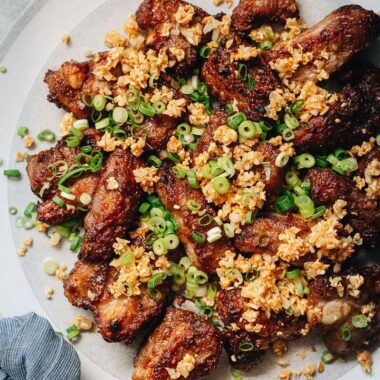
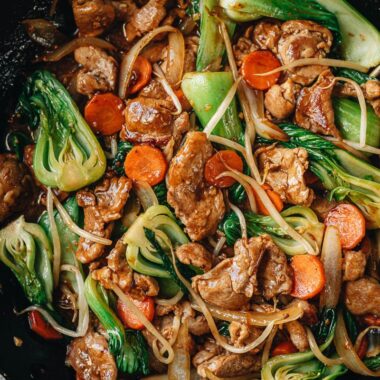
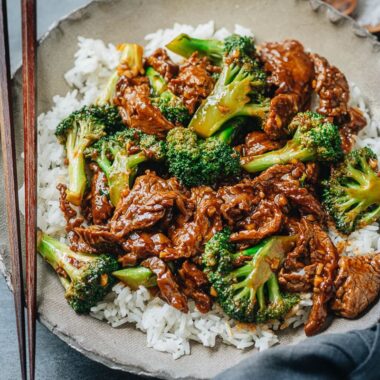
Barbara Berry
Can I use ground beef and if so what adjustments should I make?
Maggie Zhu
You can totally use ground beef! Once you marinate the beef, I would use 1 tablespoon cornstarch (instead of 1/4 cup). The cornstarch will make the beef very tender and have a nice texture. When you brown the ground beef, I would also intentionally leave some large clump of meat instead of breaking everything very small, for a nicer texture. If you ended up making the dish, please do leave a comment to let me know how it goes. I think ground beef will make a great tasting dish 🙂
Tony
A great recipe, although I substituted beef for wild venison and added a little baking soda to tenderise the venison. Turned out delicious with the extra richness of the game meat. Will certainly use this again, maybe with Canadian Goose breast
Philip
What happened to the ginger in the marinade step?
Maggie Zhu
Sorry for the typo! The ginger goes with the rest of the ingredients in the marinade.
Wolkan
I have put too much soda. Pff. Poor wasting food. I better never use it soda. My mistake. But to meat was super tender though. Hahahaha
Sue
I just found your site for the first time. This is my favorite beef stir fry receipe for sure. I am looking forward to more of your recipes.
Thank you
Steve
Another great recipe.
Elliott
This is a keeper, although it only served two😊.
I am curious if anyone has tried to cook the beef in an air fryer and if the results were worth the effort.
I used a cheap cut and added the baking soda to tenderize and the results were perfect.
Sheila Sage
This is just like take out but only better!This is great.I have been a little intimidated by asian cooking because there are lots of ingredients I am not used to cooking with.Thank you for making it not so nerve racking.
Katharine
Oh my goodness this was so good! And so easy! Used dry sherry because it was all I could find and added some baby bok choy. Will definitely be adding this to my regular rotation.
Maciej Muldner
Amazing taste. Easy to make. The taste is absolutely fantastic taste. It is even tasty if reheated the next day. Goes excellent with peanut green peas:)
Bob Adams
I had never used shaox8ng wine before. It really makes a difference. Sherry is really not the same thing.
Chloe
Hi Maggie,
I just tried your Vegan Dan Dan Noodles and they were fantastic. I didn’t have all the ingredients this time around but I managed to find everything including the mustard stem.
I am just wondering for this recipe, My soy sauce doesn’t indicate if it is dark or light. Can I just use the one kind I have or will this compromise taste if I don’t have both a light and a dark option?
Thanks!
Maggie
Hi Chloe, you can use the soy sauce (it’s probably regular if it didn’t say). The dish will come out lighter in color but it doesn’t affect taste. Glad to hear you like the dan dan noodle recipe 🙂
Lynda
Hi. Maggie, can the beef marinate over night in fridge (or several hours)? If yes, when should baking soda be added?
Thank you
Maggie
Hi Lynda, yes you can totally marinate the beef overnight in the fridge. You can actually add the baking soda at the beginning. I believe many Chinese restaurants do so to tenderize the meat.
Bernice
I don’t see baking soda in the recipe- could you confirm? I plan to make this tonight!
Maggie Zhu
You only need baking soda if using a tough cut of beef. If you plan to use flank steak (like in my recipe), you don’t need the baking soda.
For other cuts, you can use 1/4 teaspoon baking soda for 1 lb of beef. Add it during step 1, when add it with the other ingredients to marinate the beef.
Lynda
This was delicious! And good to know it can marinate longer without becoming bitter. Thank you Maggie for another wonderful dish.
Lucy L.
I love this recipe: easy and delicious. I used shaved beef from a local farm and turned out fabulous every time.
Steven
Hi,
Can I use a chicken with this recipe instead of beef?
Maggie
Hi Steven, yes, you can use chicken instead of beef to cook this recipe.
Happy cooking and hope your dish turns out great 🙂
Ernest Cechetto
Easy and delicious. Thanks
Qiuna
I made this dish yesterday for my roommates. First attempt and they absolutely adored it. I’m going to make it more often! I was wondering however, what vegetable side dishes you would recommend with this dish?
Thomas
Hi Qiuna! We’re happy to hear that the first take went well! And glad you asked about veggie sides – the three-ingredient garlic broccoli stir fry and vinaigrette cabbage stir fry are simple and tasty. If you have access to Chinese broccoli (aka gai lan) this one is really tasty. Good luck and let us know how it goes!
Gavin
This is the first time I’ve ever attempted Chinese cooking. Your recipe was simple and easy to follow. Now my favorite Mongolian Beef dish is mine/yours. I also attempted your egg drop soup. Very good. I need to practice on the egg separattion a little more. Thanks for sharing your recipes and I look forward to trying your others.
Thomas
That’s awesome, Gavin – thanks for your message and welcome to the world of Chinese cooking 🙂
Was the egg too clotted, do you mean? It can be tough to get the thin strands just right, but the key is to get the soup very hot (the cornstarch thickening also helps) and to drizzle the egg very gradually. Good luck and let us know how the other dishes turn out!
Gavin
First time attempting any sort of Chinese cooking. You made the recipe so simple and now my favorite Magnolian Beef dish is mine/yours. My egg drop soup came out great. I still need to practice the actual egg separation, but very simple. Thanks for sharing can’t wait to try your other recipes.
penny
I love this web site awesome recipes. Thankyou so much